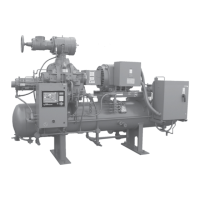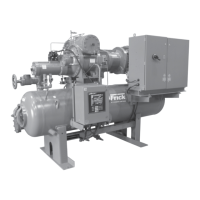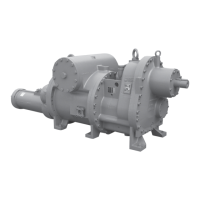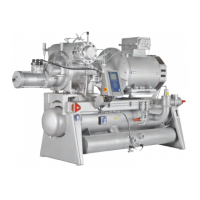RWB II ROTARY SCREW COMPRESSOR UNITS
PROPER INSTALLATION OF ELECTRONIC EQUIPMENT
070.200-IOM (DEC 11)
Page 48
In today’s refrigeration plants, electronic controls have found
their way into almost every aspect of refrigeration control.
Electronic controls have brought to the industry more pre‑
cise control, improved energy savings, and operator conve‑
niences. Electronic control devices have revolutionized the
way refrigeration plants operate today.
The earlier relay systems were virtually immune to radio
frequency interference (RFI), electromagnetic interference
(EMI), and ground loop currents. Therefore installation
and wiring were of little consequence and the wiring job
consisted of hooking up the point‑to‑point wiring and sizing
the wire properly. In an electronic system, improper instal‑
lation will cause problems that may outweigh the benefits
of electronic control. Electronic equipment is susceptible to
RFI, EMI, and ground loop currents which can cause equip‑
ment shutdowns, processor memory and program loss, as
well as erratic behavior and false readings. Manufacturers
of industrial electronic equipment take into consideration the
effects of RFI, EMI, and ground loop currents and incorpo‑
rate protection of the electronics in their designs. However,
these design considerations do not make the equipment
immune, so manufacturers require that certain installation
precautions be taken to protect the electronics from these
effects. All electronic equipment must be viewed as sensitive
instrumentation and therefore requires careful attention to
installation procedures. These procedures are well known to
instrumentation, networking, and other professions but may
not be followed by general electricians.
There are a few basic practices that if followed, will minimize
the potential for problems resulting from RFI, EMI and/or
ground loop currents. The National Electric Code (NEC) is a
guideline for safe wiring practices, but it does not necessarily
deal with procedures used for electronic control installation.
Use the following procedures for electronic equipment instal‑
lation. These procedures do not override any rules by the
NEC, but are to be used in conjunction with the NEC code
and any other applicable codes.
With exclusion of the three phase wire sizing, Frick drawing
649D4743 should be used as a reference for properly sizing
control wires and other wiring specifications.
Throughout this document the term Electronic Control Panel
is used to refer to the microprocessor mounted on the com‑
pressor package or a Central Control System panel.
NOTE: It is very important to read the installation in-
structions thoroughly before beginning the project.
Make sure you have drawings and instructions with your
equipment. If not, call the manufacturer and request the
proper instructions and drawings. Every manufacturer
of electronic equipment should have a knowledgeable
staff, willing to answer your questions or provide addi-
tional information. Following correct wiring procedures
will ensure proper installation and consequently, proper
operation of your electronic equipment.
WIRE SIZING
Control power supply wires should be sized one size larger
than required for amperage draw to reduce instantaneous
voltage dips caused by large loads such as heaters,
contactors, and solenoids. These sudden dips in voltage can
cause the electronic control panel, whether it is a micropro‑
cessor, a computer, or a PLC, to malfunction momentarily or
cause a complete reset of the control system. If the wire is
loaded to its maximum capacity, the voltage dips are much
larger, and the potential of a malfunction is very high. If the
wire is sized one size larger than required, the voltage dips
are smaller than in a fully loaded supply wire and the poten‑
tial for malfunction is much lower. The NEC code book calls
for specific wire sizes to be used based on current draw. An
example of this would be to use #14 gauge wire for circuits up
to 15 amps or #12 gauge wire for circuits of up to 20 amps.
Therefore, when connecting the power feed circuit to an
electronic control panel, use #12 gauge wire for a maximum
current draw of 15 amp and #10 wire for a maximum current
draw of 20 amp. Use this rule of thumb to minimize voltage
dips at the electronic control panel.
VOLTAGE SOURCE
Selecting the voltage source is extremely important for proper
operation of electronic equipment in an industrial environ‑
ment. Standard procedure for electronic instrumentation is to
provide a clean, isolated, separate‑source voltage in order to
prevent EMI (from other equipment in the plant) from inter‑
fering with the operation of the electronic equipment. Con‑
necting electronic equipment to a breaker panel (also known
as lighting panels or utility panels) subjects the electronic
equipment to noise generated by other devices connected
to the breaker panel. This noise is known as electromagnetic
interference (EMI). EMI flows on the wires that are common
to a circuit. EMI cannot travel easily through transformers
and therefore can be isolated from selected circuits. Use a
control power transformer of the proper VA rating, usually
provided in the compressor drive motor starter, to isolate the
electronic control panel from other equipment in the plant
that generate EMI. See Figure 40.
Figure 40
PROPER INSTALLATION OF ELECTRONIC EQUIPMENT IN AN INDUSTRIAL ENVIRONMENT

